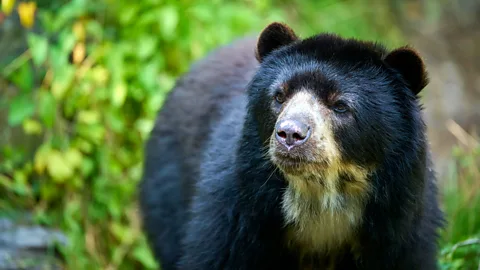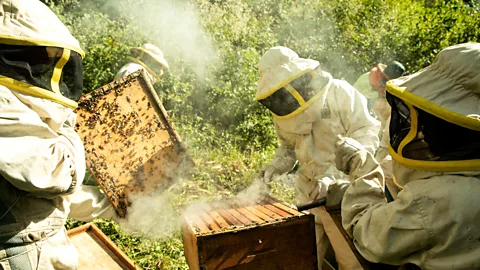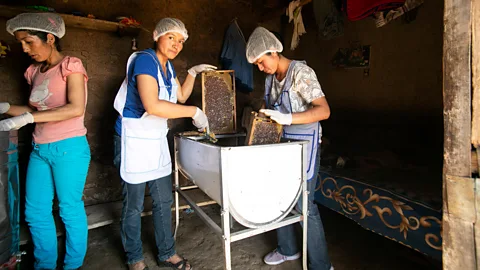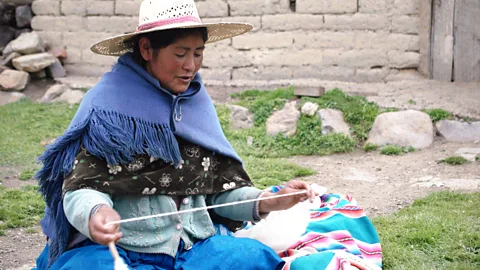Honey, not marmalade, is saving the real 'Paddington Bear'
 Getty Images
Getty ImagesDrought and conflict with farmers are threatening Bolivia's Andean bear – the real-life Paddington Bear. Now a beekeeping project is helping protect this endangered species.
Elsa Limachi looks silently at the mountains around her small straw house. She is scanning her surroundings for the Andean bear. This small "spectacled" bear, with its circular golden markings around its eyes, is the real-life Paddington Bear.
Unlike the marmalade-obsessed fictional favourite, Andean bears are not social creatures. They are difficult to spot, but they are there, roaming through the dry Andean forest in southern Bolivia, Limachi says.
The inter-Andean dry forest lives up to its name with a landscape dotted with dense trees and bushes, where green merges with yellow and brown. The earthy tones of the landscape provide the perfect camouflage for the Andean bear's dark brown fur.
Limachi lives in San Lorencito, a remote farming village in Tarija, southern Bolivia. For generations, the community saw the Andean bear as a threat which was responsible for killing their cattle and eating their crops. These often false beliefs have led to retaliatory killings in the area.
"Several years ago, we didn't want the bear around because we thought it was not only dangerous, but also harmful to our cattle and crops," says Limachi.
"The farmers would always blame the bear," Limachi says. But bear attacks were the cause of only 5% to 10% of livestock deaths, she says, adding that poor management practices of cattle, diseases, tumbling accidents or snake bites, were the main reasons for cattle losses.
Climate Guardians
This article in the Climate Guardians series was supported by funding from the European Journalism Centre, through the Solutions Journalism Accelerator. This fund is supported by the Bill & Melinda Gates Foundation.
The Andean bear's conservation status is vulnerable. The bear's main threats are retaliatory killings, habitat fragmentation and degradation, and the effects of climate change on the reproductive success of the species.
Bolivia and Peru are home to 70% of the Andean bear population, but the species can also be found in parts of Ecuador, Colombia and Venezuela. It is the only bear species residing in South America and there are an estimated 2,500 to 10,000 mature bears in the wild, according to ecological models.
In contrast to Paddington Bear, who always keeps a marmalade sandwich tucked under his hat in case of a hunger emergency, the Andean bear feeds on bromeliads, exotic plants related to the pineapple, and other hard vegetative matter growing on the mountainside. But when there is not enough food in the forest, this opportunistic hunter may attack cattle, leading to conflict with farmers.
In San Lorencito, conflict with farmers has led to illegal retaliation killings, threatening the Andean bear's long-term survival.
Witnessing the declining bear population in the region, Bolivian biologist Ximena Velez-Liendo came up with a plan to minimise conflict between farmers and bears. The solution? Beekeeping.
Velez-Liendo is the founder of the Andean Carnivore Conservation Programme (ACCP), a conservation project led by Chester Zoo in the UK along with other organisations, including WildCRU, Foundation Segré, Darwin Initiative and Whitley Fund for Nature.
The ACCP opened a communal apiary with 10 beehives in San Lorencito in 2018, which also served as a school for community members to learn the craft of beekeeping. The programme helped provide resources so each family could start their own apiary, as well as equipment to facilitate honey harvesting.
The aim was to provide the community with an alternative economic activity to cattle farming. Velez-Liendo established the beekeeping project in 2018 following a regional assessment which revealed that farming communities were killing one to two bears every year because they blamed the animals for killing their livestock. Most cattle deaths were attributed to the bear, even if other factors, such as diseases and mountain tumbling, were to blame, says the biologist.
"The objective was to reduce retaliatory killings of bears by reducing cattle farming, as well as to improve people's attitude and increase tolerance towards bears," says Velez-Liendo, also a research associate at the wildlife conservation research unit at the University of Oxford and Chester Zoo in the UK, based in Tarija.
"We do not provide the full cost of the apiary. We provide 70% of the total cost, and the beneficiary the remaining 30%," says Velez-Liendo. "We found out that people value and care more than if it had been completely free."
 Oscar Orozco
Oscar OrozcoIn 2018, there were five bears in San Lorencito – two males and three females –according to a camera trapping study by the ACCP seen by BBC Future Planet.
"Having so few individuals, and only one cub, showed us that the Andean bear was disappearing from that region," says Velez-Liendo.
Before the programme started in 2018, farmers used to find dead cows and that their crops had been eaten by bears. Limachi says she once woke up to find that the maize she grows next to her house had all been eaten by a hungry bear. She now laughs about it, but at the time it was painful.
"It was common to hear of bears being killed in the community. I used to hear that from my dad when I was a child, and then from my husband," Limachi says.
"Retaliatory killings of bears, or revenge hunting, arises when bears attack livestock or damage crops, resulting in economic losses or a perceived threat for people," says Velez-Liendo.
"Attacks on cattle and maize crops are the main causes of retaliation," says biologist Mauricio Peñaranda, who has spent six years researching human-bear conflict at San Francisco Xavier University in Sucre, southern Bolivia.
Peñaranda says that free-ranging cattle that are left to roam in the mountains are particularly vulnerable to bear attacks. "The farmers take the cattle to great areas where they can find pastures, but it is hard to keep control of the animals," he says.
"The lack of control can become an opportunity for the bear to attack, but sometimes accidents, such as snake bites or tumbling off the mountain, can cause their death," he says, adding that the bear is usually blamed, even in these instances.
Mariolina Heredia, 29, the elected secretary of San Lorencito, has four active beehives. Her harvest, which happens once to twice a year, supplements the diet of her three children.
"I wanted us to be part of the project, because I saw that it was going to be something good," she says. "I thought we could sell the honey or keep it for our own consumption…I don't sell the honey, because I use it to feed my children."
In her role as secretary, Heredia has helped to promote the beekeeping project, encouraging other members of the community to participate, and organised training courses.
Just like Heredia, Zoilo Aguirre, who is the biggest livestock farmer in San Lorencito, does not sell the honey, because he gives it to his children and grandchildren to supplement their diet and as a substitute for sugar.
His family also use propolis, the resin collected by honeybees from tree buds which they use to build their hives, as medicine. Propolis is known for its wound-healing, antiviral and anaesthetic properties.
"It's like having a pharmacy," says Aguirre. "We use the honey and propolis for coughs, toothache and colds." Each beehive produces between 400g (0.8lb) and 600g (1.3lb) of propolis per year, according to the ACCP.
 Oscar Orozco
Oscar OrozcoOther beneficiaries of the programme, such as Limachi, sell their entire harvest, about 90kg (198lb), every year for $517 (£404). "By selling the honey, I was able to pay my debts," she says.
The average monthly minimum wage in the community is $359 (£279), according to Patricia Sánchez, who oversees the economic initiatives of the ACCP. The honey sales provide roughly 30% of the families' average income, says Sánchez.
The ACCP has created the "Valle De Osos" brand, translated as "Valley of the Bears", which community members can use to market their honey as a bear-friendly product. "I consider myself a fairly conscious consumer," says Alejandra Laserna, from Cochabamba, who has been buying Valle De Osos honey since 2019, directly from the community. "I know I am choosing something good for me, but also something that is helping a community's subsistence, as well as the conservation of a species that has no power to protect itself."
For Benigno Tárraga, 68, beekeeping provides half of his monthly income of $359 (£281). He harvests honey three times a year, and by selling his honey through the "Valle de Osos" brand, he generates an annual income of $2,155 (£1,675).
"I want to get more beehives to sell more honey and keep reducing my cattle, because beekeeping requires less physical effort," says Tárraga, who sees it as a good retirement plan.
Heredia also wants to keep more beehives because there is less risk of financial loss. "If a cow dies, there is no way to recover that money. But with honey, if you take care of the beehives properly, you can have a good harvest," she says.
Initially the community were hesitant to engage with the ACCP and their beekeeping project. "The first time Ximena came, I asked her to take the bear with her, I didn't want it here," Limachi recalls, laughing.
But her attitude changed after she realised that the bear brought a wide range of benefits to the community.
"Since the beekeeping project started, we have learned that we can benefit from the bear's presence, in an environmental and economical way," Limachi says.
The Andean bear is referred to as the "gardener of the forest" because of its ability to spread seeds through its faeces, facilitating the regeneration of the ecosystems it inhabits, in this case the inter-Andean dry forest.
"The bear, by feeding on plants, spreads seeds through its faeces. The bees, on the other hand, pollinate the plants," explains Velez-Liendo.
"Bears help regenerate the forest and there is more food for the bees, because there are more flowers," says Heredia.
 Oscar Orozco
Oscar OrozcoSince the start of the project, cattle farming in the community has reduced by 17%, exceeding the projects expectations, according to Velez-Liendo.
"While some community members have sold their cattle, others have lost them due to climate factors, but in both cases, they have not replaced them," she says, adding that this is due to the beekeeping project providing them with an alternative income.
Beekeeping provides families with an alternative income stream, making them less reliant on livestock farming, according to the ACCP's Sánchez. Half of their average income now comes from cattle farming, 30% from honey and 20% from agriculture, she says.
The number of bears has increased in the area, from five adults identified in 2018, to 40 in 2024, according to the most recent evaluation of the project, seen by BBC Future Planet.
Between 2016 and 2024, no bears were killed in retaliation attacks, according to the ACCP. However, in 2019 a dominant male was killed for its fur.
The project has also increased the average income of families in San Lorencito by 15% and increased the household's ability to generate income by 11.8%, between 2018 and 2021.
Tolerance towards bears has increased by 50% according to the same report, based on a survey conducted in 2019, where they found that only 10% of cattle deaths were attributed to the bear.
Aguirre, San Lorencito's biggest livestock farmer, has taken a proactive role to avoid conflict with the bear, by planting pastures in an area where he can have control of his livestock.
"I try to avoid free-ranging animal husbandry, because I know the bear is there and I would be taking the cattle to its door," he says.
The success of the programme led the ACCP to introduce their conservation initiative in two other areas in the inter-Andean dry forest this year.
Velez-Liendo says the project can be replicated in other areas, but only if communities are willing to participate.
CARBON COUNT
The emissions from travel it took to report this story were 70kg CO2. The digital emissions from this story are an estimated 1.2g to 3.6g CO2 per page view. Find out more about how we calculated this figure here.
She says one of the biggest limitations the programme has found is the lack of conservation professionals in the region. This means that agronomists, veterinarians and sociologists have been brought in from different cities, which hinders the continuity of the work, she says.
Similar other initiatives are being implemented across Bolivia, addressing not only human-bear conflict, but also landscape conservation.
"We have published a study identifying the main strongholds for the conservation of the Andean bear in both Peru and Bolivia, and the good news is that they are relatively large areas," says Robert Wallace, a senior conservation scientist for the Wildlife Conservation Society (WCS) in the Andes, Amazon and Orinoco regions.
The Andean bear is a landscape species, which means that it needs large spaces to have viable populations, Wallace says. "It needs between 11.5 sq miles (30 sq km) and 38.6 sq miles (100 sq km) per individual, although they can overlap."
The same study revealed that there were larger populations of Andean bears in the country's protected areas in western Bolivia, leading the WCS to focus its work on supporting local authorities and communities there.
 William Wroblewski
William WroblewskiAnother conservation initiative is being implemented in the municipality of Tiquipaya in Cochabamba in central Bolivia, by Andrea Fuentes Arze, who works for the environmental non-profit Vida Silvestre. She runs the Jucumari programme that aims to reduce conflict with the Andean bear, by providing the local community with an alternative economic activity to livestock farming.
Here the focus is artisanal weaving, rather than beekeeping. The Jucumari programme trains women in different weaving techniques, to create handicrafts such as small woven Andean bears, loom woven blankets and table runners that are later sold in towns. The sale of these woven items provides about 15% of the women's total income, says Fuentes Arze.
The project has not only helped reduce conflict with the bear, but also empowered local women and provided an alternative income for their families, she says. "There is a greater tolerance for conflict in the communities where we work. We can see their frustration when they lose a cow, but at least the women can now get over this bitter pill, with a little more vision."
For Velez-Liendo, the key is finding ways for humans and bears to coexist, while improving people's livelihoods and protecting bear strongholds in the Andes.
"Bears have lived in these forests for thousands of years, even before the arrival of the human species in the Andes. Today, bears and humans share the same landscape," she says. "A bear does not kill cows as revenge to humans for taking their forest."
"We are focused on increasing people's tolerance towards bears, and providing economic alternatives to livestock, so next time a bear kills a cow or steal some maize, people will simply say: 'cheeky bear'."
--
Correction: This story originally stated the bear was also found in Argentina. This was corrected on 23 August, as the bear is not found in this country.
--
For essential climate news and hopeful developments to your inbox, sign up to the Future Earth newsletter, while The Essential List delivers a handpicked selection of features and insights twice a week.
